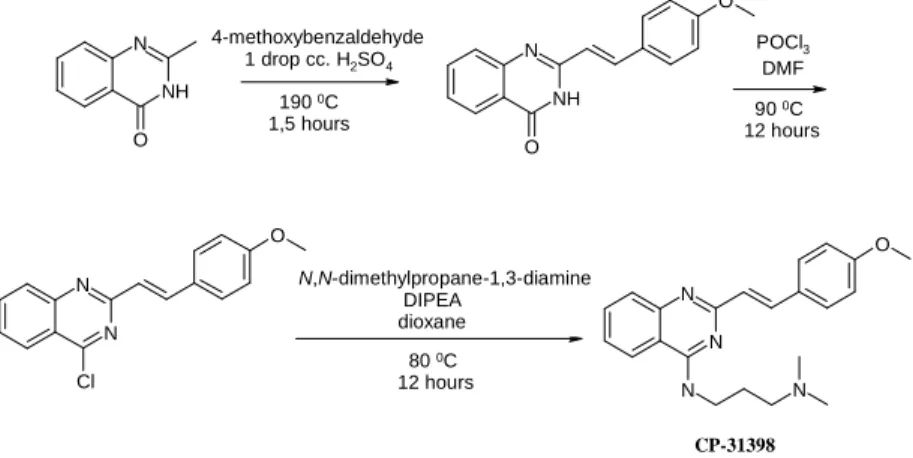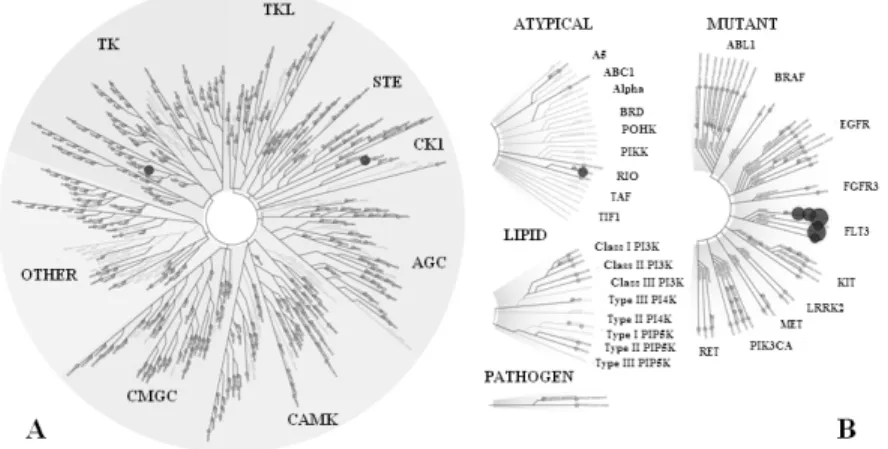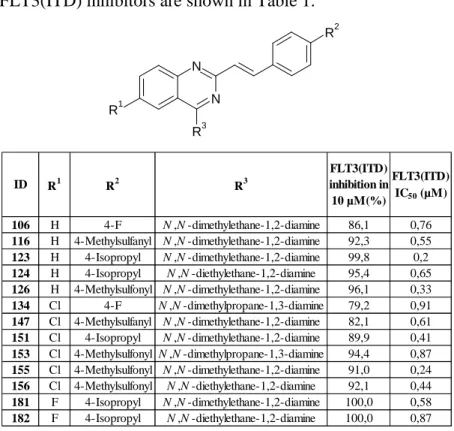Preparation and examination of novel kinase inhibitors for the treatment of cancer
PhD thesis
Ferenc Baska
Semmelweis University
School of Pharmaceutical Sciences
Supervisor: László Őrfi Ph.D.
Official reviewers: Gábor Krajsovszky Ph.D.
György Miklós Keserű D.Sc.
Head of the Theoretical Exam Committee: Éva Szökő D.Sc.
Members of the Theoretical Exam Committee: György Dombi D.Sc.
József Nyitrai D.Sc.
Budapest
2014
1. INTRODUCTION
Cancer diseases are the most common causes of death not only in Hungary but in other countries of the world as well.
Using new and sophisticated screening and diagnostic methods, some tumors can be detected in their early stage, but neither surgical removal nor chemotherapy can guarantee complete recovery.
The development of malignant tumors often occurs due to abnormal signal trasduction processes. The signals induced by growth factors are mediated through various phosphorylation cascades from the cell surface receptors towards the nucleus.
The key enzymes of these mechanisms are the protein kinases. The generally known oncogenes encode kinase enzymes, therefore the pharmaceutical drug discovery mainly focuses on the development of novel kinase inhibitors.
My research in the field of kinase inhibitors can be divided into two main parts.
In the first part my task was to examine the binding mode of novel B-RAF kinase inhibitors and to determine their biological activity profile.
The greater part of my PhD work was to synthesize and examine molecules which kinase inhibitory profile was
the first compounds we identified the FLT3 kinase as target and we concluded that the molecules are selective FLT3 inhibitors.
The present thesis summarizes the results of my research in the development of B-RAF and FLT3 kinase inhibitors.
1.1. The B-RAF kinase and its role in the development of cancer
One of the most studied signal transduction pathway is the RAS/RAF/MEK/ERK cascade, which transmits signals from the receptors to the nucleus, thereby controlling the cell proliferation, differentiation and survival. The B-RAF kinase belongs to the serine/threonine protein kinase family and is a crucial member of this pathway. Mutation and abnormal activation of the kinase occurs mainly in melanomas, colon and thyroid tumors, but it can be in the background of other cancer types as well.
One of the most common mutation of B-RAF is the V600E (earlier referred as V599E) point mutation which means a glutamic acid/valine substitution at position 600 in the primary structure of the protein.
Since the incidence of this mutation is close to 60% in melanomas, the development of B-RAF(V600E) inhibitors are important for the treatment of this type of cancer.
1.2. The FLT3 protein kinase
FLT3 is a tyrosine kinase which belongs to the third subgroup of receptor kinases and its structure is similar to the c-Kit, FMS (CSFR) and PDGF kinases.
The immature blood cells express the kinase in the highest extent in the human body and the enzyme is important for the proper function of hematopoietic stem cells and the immune system. The protein can be found on the cell membrane in monomer state. The binding of the FLT3 ligand (FL or FLT3L) induces the activation of the kinase which leads to conformational changes (dimerization) and to the autophosphorylation of the intracellular part.
The activated FLT3 kinase uses several signal transduction pathways to transmit the information in the direction of the nucleus. The two most important pathways are the PI3K/Akt and MAPK (RAS / RAF / MEK / ERK), which control the transcription, translation, differentiation and apoptosis.
The overexpression of FLT3 kinase was observed in the malignant tumors of the hematopoietic system and it is particularly common (~70-100%) in acute myeloid leukemia (AML). The two most important mutations are the internal tandem duplication (ITD) and the D835 point mutation on the kinase domain. The ITD mutation has the worst prognosis considering drug resistance and survival, therefore there is a high demand for an FLT3/ITD selective inhibitor in the therapy of AML.
2. OBJECTIVES
Joining to the research groups of Vichem Chemie Ltd. and Cooperation Research Centre my first objective was to identify compounds that inhibit the B-RAF kinase, because the development of such molecules represents a key area of cancer drug discovery. My aims in this topic can be divided into four main points:
1. Examination of the binding mode of published B-RAF inhibitors, and using the gained information to determine the binding mode of the developed compounds by molecular modeling.
2. Validation of the in silico results using in vitro biochemical assays.
3. Determination of the effect of the molecules on B-RAF kinase expressing cell lines.
4. Binding kinetics studies and measurements.
My other main objective was to synthesize patentable kinase inhibitors and study their structure-activity relationships. The CP-31398 styrylquinazoline derivative was published in 1999 as a p53 protein activator molecule. The kinase inhibitory effect of the compound has not been studied yet, although several well-known inhibitor (gefitinib, erlotinib, tandutinib, vandetanib) contains the same quinazoline core. Therefore my goals were:
1. Preparation of CP-31398 and the creation of a styryl- quinazoline compound library.
2. The determination of the kinase inhibitory profile of the compounds.
3. Structure-activity relationship studies using in vitro biochemical assays.
4. Efficiency tests on several tumor cell lines.
5. Penetration studies using PAMPA assay.
3. METHODS
3.1. Examination of potential B-RAF kinase inhibitors The Vichem Chemie Research Ltd. and the Max Planck Institute have developed numerous AXL kinase inhibitors bearing sulfonamide moiety, from which approximately 450 active compounds were patented.
The sulfonamide functional group often occurs in the published B-RAF inhibitors, thus based on similarities twelve compounds (Figure 1) were selected for further tests.
N O
O R4
O
H N
S O O
R1 R2
R3
Figure 1 General structure of the examined BRAF inhibitors.
The biological evaluation of the compounds were carried out using in vitro biochemical assays, tumor cell lines and binding kinetic studies applying the reporter displacement assay.
3.2. Preparation and evaluation of styrylquinazoline derivatives
I have used the SciFinder ScholarTM and Reaxys databases for the data collection about the preparation of the CP-31398 reference compound.
Although the structure of the compound was described in a Science article (1999) and a patent (2000), at the beginning of my research (2007) the synthesis of the molecule had not been published yet. Therefore I have developed a process for the preparation (Figure 2) using analogue reactions from the literature. The substituted styrylquinazoline derivatives were synthesized on the basis of this synthetic route.
NH N
O
O
NH N
O
N N
Cl
O
N N
N
O
N CP-31398
4-methoxybenzaldehyde
1 drop cc. H2SO4 190 0C 1,5 hours
POCl3 DMF 90 0C 12 hours
N,N-dimethylpropane-1,3-diamine DIPEA
dioxane 80 0C 12 hours
Figure 2 Developed synthesis method for CP-31398
The biological effects and the selectivity of the molecules were tested using biochemical assays, tumor cell lines, flow cytometry (FACS) and permeability (PAMPA) assays.
4. RESULTS
4.1. Examination of potential B-RAF kinase inhibitors The binding mode of the B-RAF inhibitors was studied using molecular modeling methods.
According to the docking studies similar interactions to the published B-RAF inhibitors could be detected: hydrogen bonds with the hinge region and with the DFG motif, as well as hydrophobic interactions with the amino acids of the ATP binding site.
Sorafenib was used as a reference compound for the biochemical assays. Sorafenib inhibited the wild type B-RAF with a 0,11 µM IC50 and the mutant B-RAF(V600E) with a 0,07 µM IC50 value.
Five of our compounds showed nanomolar IC50 values (IC50< 0.68 µM), six showed no remarkable activity (IC50= 1- 20 µM) and one compound was completely inactive (IC50> 23 µM) against the B-RAF kinases.
Figure 3 Measured IC50 values on cell lines harbouring wild type B-RAF
Figure 4 Determined IC50 values on cell lines harbouring V600E mutant B-RAF
We also measured the effect of the molecules on wild-type and mutant B-RAF(V600E) expressing tumor cell lines (Figure 3 and 4). As the result of the tests we found that the
compounds were less or not active against wild-type B-RAF expressing cell lines (MeWo, M24met), while on those that contain the V600E mutation (HT29, A375p, UACC257) the compounds showed good effect. This is noteworthy, because in the kinase assays they were almost equally effective on both enzymes.
A special behavior of the wild type B-RAF expressing cells may be responsible for these different effects. Using siRNA and western blot methods it was found that the increased MAPK pathway activation was the result of an A- and/or C-RAF kinase activation.
The compounds were screened in a displacement assay to gain information about their binding kinetics. We found that our compounds have fast binding kinetics. Based on the docking results and the similarities with the published inhibitors we classified them as type I ½ kinase inhibitors.
4.2. Preparation and evaluation of styrylquinazoline derivatives
Using the developed synthetic route for CP-31398 I have synthesized additional 122 styrylquinazoline and 2 styrylpyrimidine derivatives.
The kinase inhibitory profile was determined by the DiscoveRx KINOMEscan® method and we identified FLT3 kinase as target of the molecules (Figure 5).
in case of mutant FLT3 kinases we found > 90%
5µM compound concentration. Although lower binding affinity was measured against other kinases (CSNK1A1 77%
GAK 65% and RIOK1 63%, but in 5µM concentration these values were not significant.
Figure 5 The selectivity illustrated on the kinase tree. Target proteins are shown on Figure A and the percentage of protein binding can be seen on Figure B
All compounds were tested first in a kinase assay (IMAP) at a single point concentration (10 µM). Our aim was to sort The kinase inhibitory profile was determined by the identified the . Moreover,
> 90% binding in ough lower binding (CSNK1A1 77%, M concentration these
tree. Target and the percentage of protein
in a kinase assay (IMAP) aim was to sort
selected for the more precise IC50 measurements. Our best FLT3(ITD) inhibitors are shown in Table 1.
R2
R1
R3 N N
Table 1 The biological effect of the best FLT3(ITD) inhibitors
The compounds were tested on MV4-11 acute myeloid leukemia cell line. These measurements were also important because this cell line contains the FLT3 (ITD) mutation and increased expression was also manifested. Compounds having good FLT3 kinase inhibitory effect showed significant
ID R1 R2 R3
FLT3(ITD) inhibition in 10 µM(%)
FLT3(ITD) IC50 (µM)
106 H 4-F N ,N -dimethylethane-1,2-diamine 86,1 0,76
116 H 4-Methylsulfanyl N ,N -dimethylethane-1,2-diamine 92,3 0,55 123 H 4-Isopropyl N ,N -dimethylethane-1,2-diamine 99,8 0,2 124 H 4-Isopropyl N ,N -diethylethane-1,2-diamine 95,4 0,65 126 H 4-Methylsulfonyl N ,N -dimethylethane-1,2-diamine 96,1 0,33
134 Cl 4-F N ,N -dimethylpropane-1,3-diamine 79,2 0,91
147 Cl 4-Methylsulfanyl N ,N -dimethylethane-1,2-diamine 82,1 0,61 151 Cl 4-Isopropyl N ,N -dimethylethane-1,2-diamine 89,9 0,41 153 Cl 4-Methylsulfonyl N ,N -dimethylpropane-1,3-diamine 94,4 0,87 155 Cl 4-Methylsulfonyl N ,N -dimethylethane-1,2-diamine 91,0 0,24 156 Cl 4-Methylsulfonyl N ,N -diethylethane-1,2-diamine 92,1 0,44 181 F 4-Isopropyl N ,N -dimethylethane-1,2-diamine 100,0 0,58 182 F 4-Isopropyl N ,N -diethylethane-1,2-diamine 100,0 0,87
antitumor activity (IC50< 1 µM) on this cell line, which is in a correlation with the biochemical results.
It was published that the reference compound CP-31398 can restore the function of the p53 protein and also increases the expression of the tumor suppressor. We screened our compounds on several cell lines (A431, HCT116, HT29, MCF7) that harbour p53 mutation. On these cells we measured substantially weaker effect (IC50>> 1µM) than on the FLT3 expressing MV4-11 cells.
Flow cytometry (FACS) was used to determine the cell death process. The results showed that the molecules induce programmed cell death (apoptosis) instead of necrosis.
According to the permeability assay (PAMPA) the compounds have good penetration value and can cross the cell membranes with passive diffusion.
5. CONCLUSIONS
5.1. Examination of potential B-RAF kinase inhibitors Using molecular modeling methods I have predicted the binding affinity of 12 sulfonamide derivatives to the B-RAF kinase. The in silico results were validated using biochemical
activity (IC50< 0.68 µM). We tested the compounds on B- RAF expressing cell lines and concluded that the best derivatives inhibit the growth of the B-RAF(V600E) mutant tumor cell line equally to sorafenib.
The binding kinetics were determined and due to the results, the compounds were classified as type I ½ kinase inhibitors.
5.2. Preparation and evaluation of styrylquinazoline derivatives
The large number of the synthesized molecules gave us the opportunity to establish a detailed structure-activity relationship study, for which we used the in vitro biochemical results (percentage enzyme inhibition and IC50 values).
According to these results the following conclusions could be made (Figure 6):
R1
R2
R4
R3
4
N3 2
N
1 7
6 5 8
Figure 6
• The quinazoline core is essential for the FLT3 inhibitory effect, the pyrimidines are ineffective.
• The quinazoline ring can be unsubstituted or monosubstituted, while the disubstituted compounds are ineffective.
• Incorporation of a halogen atom at the 6th position does not substantially alter the effect. However the fluorinated derivatives are a bit worse than the molecules containing bromine or chlorine at this position.
• Compounds having a substitution in the 7th and 8th position are ineffective.
• The benzo[g]quinazoline based molecules condensed with benzaldehydes are also ineffective.
• The R3 group can be a substituted phenyl or a thiophene ring.
• In the case of the unsubstituted quinazolines the substituted phenyl derivatives are effective but the thiophene analogs do not show any activity. However considering the tricyclic compounds, the thiophene derivatives are active while the substituted phenyl derivatives are completely inactive.
• The R3 group has to be a monosubstituted aromatic ring for
disubstituted phenyl group showed reduced effect and the 3,4,5-trisubstituted phenyl containing molecules are completely ineffective.
• The para substitution of the R3 phenyl ring is the most preferred, substituents in the meta position greatly reduce the effect. The best substituents are the isopropyl, methylsulfonyl and methylsulfanyl functional groups.
• The R4 group has to be a side chain which improves the solubility and contains a tertiary amino group. The shorter chains (N,N-dimethylethane-1,2-diamine, N,N- dimethylpropane-1,3-diamine) are much better than the longer and larger (N,N-diethylpropane-1,3-diamine, N1,N1- diethylpentane-1,4-diamine, morpholine, N- methylpiperazine or pyrrolidine) ones.
• The presence of the styrylquinazolin core and the side- chain is essential for the activity. Compounds without side chains have absolutely no effect, the same way as the double bond reduced derivatives.
6. LIST OF OWN PUBLICATIONS Publications in the topic of the thesis
Baska F, Szabadkai I, Sipos A, Breza N, Szántai-Kis Cs, Kékesi L, Garamvölgyi R, Nemes Z, Baska F, Neumann L, Torka R, Ullrich A, Kéri Gy, Őrfi L. (2014) Pharmacophore and Binding Analysis of Known and Novel B-RAF Kinase Inhibitors. Curr Med Chem, 21: 1938-1965. (IF: 4,070)
Szokol B, Gyulavári P, Kurkó I, Baska F, Szántai-Kis Cs, Greff Z, Őrfi Z, Petak I, Ullrich A, Őrfi L, Vántus T, Kéri Gy.
(2014) Discovery and biological evaluation of novel dual EGFR/c-Met inhibitors. ACS Med Chem Lett, 5: 298-303.
(IF: 3,311)
Szokol B, Gyulavári P, Baska F, Kurkó I, Greff Z, Szántai- Kis Cs, Őrfi Z, Peták I, Ullrich A, Vántus T, Kéri Gy, Őrfi L.
(2013) Development and biochemical characterization of EGFR/c-Met dual inhibitors Acta Pharm Hung, 83: 121-133.
Baska F, Székely ER, Szántai-Kis Cs, Bánhegyi P, Hegymegi-Barakonyi B, Németh G, Breza N, Zsákai L, Greff Z, Pató J, Kéri Gy, Őrfi L. (2013) Development and study of
structure-activity relationship of drugs against Mycobacterium tuberculosis Acta Pharm Hung, 83: 88-95.
Patent in the topic of the thesis
Baska F, Őrfi L, Kéri Gy, Bánhegyi P, Kékesi L, Zsákai L.
(2013) Styryl quinazoline derivatives as pharmaceutically active agents. Hungarian Intellectual Property Office, Number: P1300477/1. Date of submission: 09.08.2013.
The PCT patent application will be submitted until 09.08.2014.



